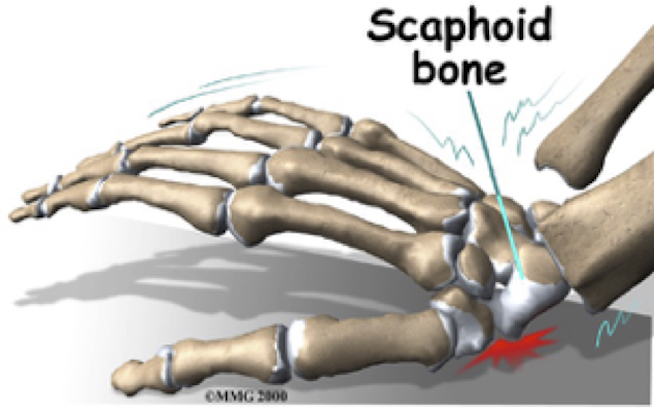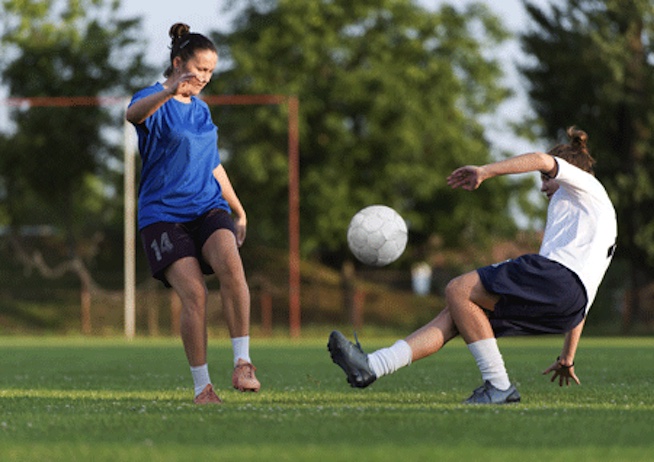Scaphoid Fractures: How They Happen, Signs You Have One, and How To Treat It
The scaphoid bone is one of eight carpal bones in the wrist. It is situated on the thumb side of the hand and wrist connecting the two rows of carpal bones together in an anatomical snuffbox. Its location ultimately makes the scaphoid more susceptible to injury, and it is the most commonly broken carpal bone.

Mechanism of Injury
The most common mechanism of injury to the scaphoid is falling on an outstretched hand—also known as a ‘FOOSH’ injury. The bone can also be fractured by a direct blow in a contact or collision sport.

Sports or activities in which scaphoid fractures happen most frequently include football, basketball, soccer, baseball, weightlifting, rugby and gymnastics.
Signs and Symptoms
Pain and swelling on the thumb side of the hand are typically noted, along with point tenderness in the anatomical snuffbox. The injury often goes undetected and undiagnosed, because it causes no physical deformity to the hand and wrist and does not impede normal range of motion. Yet early and proper diagnosis is essential to the health of the hand, or it can lead to complications in the wrist and hand or to necrosis (or death of the bone) due to receiving minimal blood flow.
If an athlete is suspected of having a scaphoid fracture, he/she is referred to an orthopedic physician for X-Ray and MRI diagnosis.
Treatment
If the bone is not out of place at the fracture point, treatment is fairly easy. The area is immobilized and put into a cast for at least 6 weeks. If the fracture is out of place, surgery is typically recommended to insert pins to reset the fractured part of bone in the proper place.
After casting or immobilization is removed, the athlete will complete physical therapy to help restore normal range of motion and strength.
RECOMMENDED FOR YOU
MOST POPULAR
Scaphoid Fractures: How They Happen, Signs You Have One, and How To Treat It
The scaphoid bone is one of eight carpal bones in the wrist. It is situated on the thumb side of the hand and wrist connecting the two rows of carpal bones together in an anatomical snuffbox. Its location ultimately makes the scaphoid more susceptible to injury, and it is the most commonly broken carpal bone.

Mechanism of Injury
The most common mechanism of injury to the scaphoid is falling on an outstretched hand—also known as a ‘FOOSH’ injury. The bone can also be fractured by a direct blow in a contact or collision sport.

Sports or activities in which scaphoid fractures happen most frequently include football, basketball, soccer, baseball, weightlifting, rugby and gymnastics.
Signs and Symptoms
Pain and swelling on the thumb side of the hand are typically noted, along with point tenderness in the anatomical snuffbox. The injury often goes undetected and undiagnosed, because it causes no physical deformity to the hand and wrist and does not impede normal range of motion. Yet early and proper diagnosis is essential to the health of the hand, or it can lead to complications in the wrist and hand or to necrosis (or death of the bone) due to receiving minimal blood flow.
If an athlete is suspected of having a scaphoid fracture, he/she is referred to an orthopedic physician for X-Ray and MRI diagnosis.
Treatment
If the bone is not out of place at the fracture point, treatment is fairly easy. The area is immobilized and put into a cast for at least 6 weeks. If the fracture is out of place, surgery is typically recommended to insert pins to reset the fractured part of bone in the proper place.
After casting or immobilization is removed, the athlete will complete physical therapy to help restore normal range of motion and strength.










